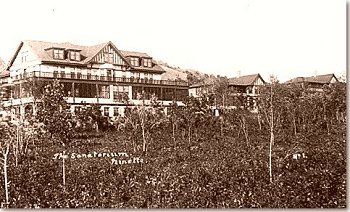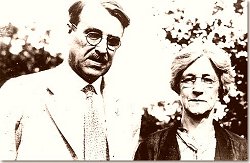
|
Dr. David Alexander Stewart (1874-1937) |
Dr. David A. Stewart was the eldest son of Francis Beattie Stewart and Elizabeth Farquharson Stewart who left Aberdeenshire in the UK, and settled at Fletcher, Ontario, until 1891 when they moved to Morden, Manitoba.
After graduation from Arts, and two preliminary years in Theology at Manitoba College, the young Stewart spent his summer at the mission in Frank, Alberta. Here, he met and befriended Dr. George Malcolmson, who had recently opened a small hospital beside his home. As a result of his summer with Dr. Malcolmson, Stewart opted for a change in vocation.
|
|
|
Returning again to Manitoba in the Fall, Stewart resumed study not in Theology, but in Medicine, and emerged four years later, Dr. D.A. Stewart. To support his medical studies, Stewart became a reporter for the Winnipeg Free Press, and then followed with a residency at Winnipeg General Hospital. After spending some time working in various hospitals in New York City, attending the World TB Congress in Washington in 1908, and completing an assistantship in a Connecticut sanatorium, Dr. Stewart returned once again to Manitoba. At this time, he accepted a position with the Sanatorium Board, who wished to open a tuberculosis sanatorium in Manitoba. Dr. Stewart's dedication to his cause, applied through travel and lectures for raising funds, made him a target for the very disease he was trying to fight. For a short time, Dr. Stewart became a patient himself, at the Trudeau Sanatorium at Saranac Lake, New York

|
|
The original buildings of the Ninette Sanatorium, from a postcard. |
Dr. Stewart returned once again to Manitoba, as Superintendent of the sanatorium at Ninette, which was now built but suffered under a lack of leadership. For the next 37 years, until his death, Dr. Stewart was responsible for the success of the sanatorium at Ninette, as well as other anti-TB measures in Manitoba. His accomplishments include: an increased emphasis on public education; the institution of travelling TB clinics in 1926; the opening of the Central TB Clinic in Winnipeg in 1930, which served as a clearing house; special TB training placements for medical students--a global first; and provision of funds for sufferers of TB who could not afford treatment on their own, before such programs existed in any other province.

|
|
Doctor D.A. Stewart during the early 1930s, with his wife, whom he treated as a patient at Ninette for many years after they were married. |
Dr. Stewart served as President of the Manitoba Medical Association, and was Chairman of the Committee on Ethics of the Canadian Medical Association--for whom he wrote a completely new Code of Ethics, published after his death. His career at the Ninette Sanatorium saw the TB rate fall to one fifth of its previous stature. A memorial stone and plaque were erected at the Ninette San, in 1940, to honour Dr. Stewart. Although the sanatorium crumbles around it, the rock still stands as a testimonial to a distinguished medical career and a man instrumental in the fight against TB in Canada.
|




